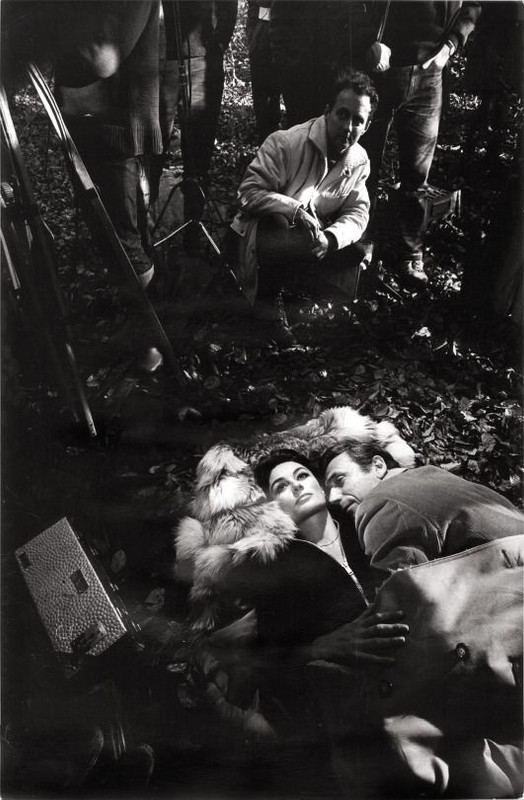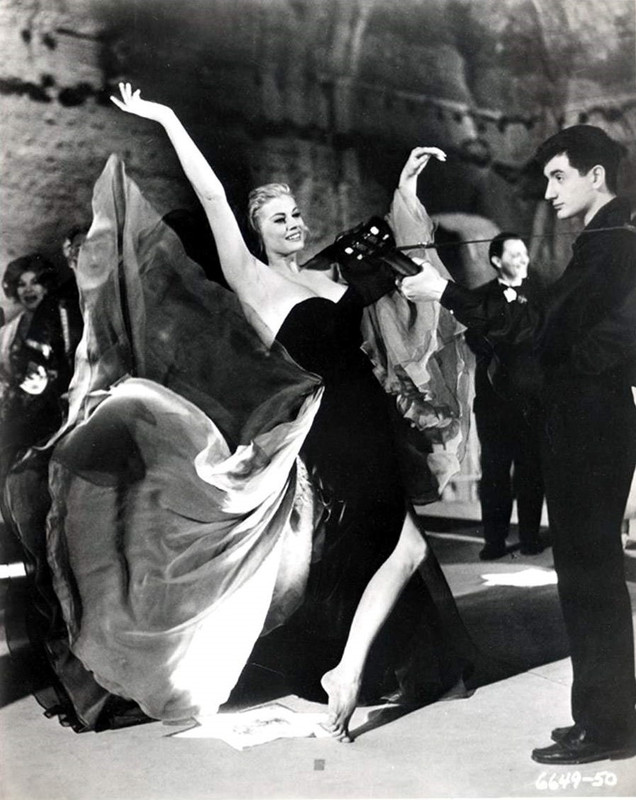Un soir, un train [One Night, a Train] (André Delvaux, 1968)
Mar
18
André Delvaux

Anouk Aimée and Yves Montand in character on a leaf-strewn floor, his head resting on her chest, with director André Delvaux and others surrounding them. DP: Ghislain Cloquet.
A favourite film, director, or producer for Luc Besson's birthday (1959).
Having only seen three of Delvaux's films, I feel I can safely say his work is hypnotic, but not in the common sense. We see a world through both Delvaux's and his protagonists eyes, and experience their duality as one. This displacement is a recurring theme in Delvaux's work, the work of a man raised in one world and speaking the language of another, both worlds bearing the same name, Belgium.
This slow tear is also the theme is his best known film, De man die zijn haar kort liet knippen [The Man Who Had His Hair Cut Short] (1965), in which a schoolteacher loses himself after a pupil graduates. When we think we are firmly seated in Delvaux's universe, we fall back, like that moment just before sleep sets in. And again, in his tragically under-seen Belle from 1973. Now it's a poet who finds a woman living in a ramshackle hut in Belgium's peatland, her language an unknown. With only one main speaker, the duality forms in the poet's words, in his attempts to give her root.
And so do we, the viewers. We hang on to that root, Delvaux's, only to sink back into our own loss of words.
AnoukAimée
Un soir, un train [One Night, a Train] (André Delvaux, 1968)
Mar
20
French Language Day

Mathias (Montand) and Anne (Aimée) walk through a round archway. Both have a different focus and are on opposite sides of the arch as a foreshadowing of their parting. DP: Ghislain Cloquet.
A Walloon language professor and his French set designer fiancée are at an impasse. While his Flemish students vocally protest against more Walloon influence at their uni, the couple – who superficially speak the same #language, #French – struggles to find the right words. They meet, part ways, then find each other again on a train that at morning turns out to be standing still in the middle of nowhere. The man, now without her, disembarks and with two acquaintances who also were on that train tries to find out where he and she are.
André Delvaux's Un soir, un train is a masterpiece about finding the right language in a fractured world.
“It's foolish to refuse happiness.”Un homme et une femme A Man and a Woman] (Claude Lelouch, 1966)
Mar
18
International Sports Car Racing Day

Jean-Louis Trintignant driving a Matra single-seater at the Autodrome de Montlhéry [caption taken from a photo from the same session]. Behind him his uncle Maurice in a Maserati Tipo 151/1. DP: Claude Lelouch.
A man and a woman meet and fall in love. The woman – Anouk Aimée – still mourns the loss of her stuntman husband, while the man – Jean-Louis Trintignant – is alone since his partner took her life, incapable of dealing with his near-fatal #crash at #LeMans.
#Trintignant came from a family obsessed with race car driving and was an avid amateur driver himself. His uncle, the #GrandPrix racer Maurice Trintignant, can be seen driving a #Maserati Tipo 151/1 during the race scene.
A deceptively simple film by Claude Lelouch, with an equally breezy soundtrack by Francis Lai.
“I like lots of things. But there are three things I like most: love, love, and love.”La dolce vita (Federico Fellini, 1960)
Mar
15
National Shoe The World Day

An exuberant Sylvia (Anita Ekberg) dances barefoot to a stoic guitarist. DP: Otello Martelli.
Various characters lose their shoes in Fellini's hedonistic La dolce vita, most famously Anita Ekberg after entering a freezing Fontana di Trevi with paparazzo Marcello Mastroianni.
– Sylvia